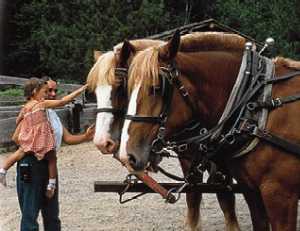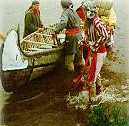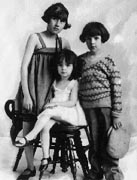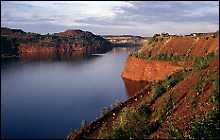Places to go & Things to do near Iowana Beach
During your stay at Iowana Beach Resort you will find beautiful and peaceful surroundings. You can enjoy the many fun resort activities as well as the surrounding area attractions. You can find everything from historical landmarks and miracles of nature to amusement parks and golf courses. Click on the links below to learn more about area attractions.
Golf
 With four 18-hole
championship courses and several more nine-hole courses
found within an easy drive of Iowana Beach Resort, you are certain to find
a tee-time to suit your needs. Very few northern resort areas offer the
many choices we do. Area courses include a wide variety of golf to
accommodate all skill levels. For the most enjoyable time, call
ahead to set a tee time.
With four 18-hole
championship courses and several more nine-hole courses
found within an easy drive of Iowana Beach Resort, you are certain to find
a tee-time to suit your needs. Very few northern resort areas offer the
many choices we do. Area courses include a wide variety of golf to
accommodate all skill levels. For the most enjoyable time, call
ahead to set a tee time.
Finally, who says price doesn't matter? You'll find that Northwoods golf offers very affordable golf fees with some of the best values in the Midwest.
| Area Golf Courses | ||||
| Golf Course | Total Yards |
Instruc. Avail |
Phone Number |
Directions Location |
| Eagle Ridge Golf Club | 6,245 | Yes | 218-245-2217 |
One Green Way, Coleraine Hwy 169 East, Coleraine |
| Pokegama Golf Club | 6,105 | Yes | 218-326-3444 |
3910 Golf Course Road Grand Rapids |
| Sugarbrooke Golf Club | 6,545 | Yes | 218-327-1462 |
Located at Ruttger's Sugar Lake Lodge |
| Wendigo Golf Club | 6,460 | Yes | 218-327-2211 |
750 Golf Crest Drive Grand Rapids |
| Blueberry Hills Golf Course | 3,121 | Yes | 218-246-8010 |
1 mi. N of Deer River on Hwy. 6, turn E on G.C. Rd. |
|
Edge of the Wilderness Golf Club |
2,963 | Yes | 218-743-3626 |
1.5 miles E of Bigfork Cty Rd 261 & G.C. Rd |
| Bemidji Town & Country Golf Club | 6,179 | Yes | 218-751-9215 | Birchmont Beach Road |
| Castle Highlands | 5,090 | No | 218-586-2681 |
10 miles N of Bemidji at Hwy. 71 and Cty Rd 23 |
| Greenwood | 3,008 | Yes | 218-751-3875 | 6 mi. E
of Bemidji on Swenson Rd Hwy 2 to Cty. Rd 8, travel 7 miles to Swenson Road, travel N 1 1/2 miles. |
| Maple Ridge Golf Course | 2,000 | No | 218-751-8401 | South of Bemidji on Beltrami Line Rd - 1 mile E of Hwy 71 S |
| Hidden Hills Pitch-n-Putt | 482 | No | 218-327-0378 |
320 SE 21st Street Behind Target in G. Rapids |
| Swan Lake Golf Club | 3,235 | No | 218-885-3543 |
Rt. 1 Box 308 Pengilly Directly off Hwy. 65 |
Top of Page
Amusement Parks
Paul Bunyan Amusement Park: Amusement Rides for All Ages. Miniature golf with a Paul Bunyan Theme. Located next to the Tourist Information Center and Paul Bunyan and Babe the Blue Ox Statues. Generally open from Memorial Day Weekend to Labor Day. Hours: 10:00 A.M. until dusk, weather permitting.
Paul Bunyan Animal Land: Feed and pet tame wildlife including pygmy goats, lambs, calves, ponies, fox, raccoons, exotic birds and everyone’s favorite – deer (4 species). Trout pond. Over 85 animals representing every continent. Home of the legendary whitetail deer - BJ - Feed him, pet him and take your picture with him. Open Memorial Day - Labor Day, 7 days a week. 10:00 to 6:00. 218-759-1533
Putt-N-Go Amusement Park: It’s a bonanza of fun in one place with a giant waterslide (smooth riding fiberglass flume, heated pool water, curves, drops & tunnel), go-carts, miniature golf, bumper boats, batting cages, showers, changing rooms and special attractions for children. Open 7 days a week Mid-May to September 11 AM - 10 PM. 218-751-7333
Itasca State Park
Within Itasca's 32,000 acres you will find the Headwaters of the Mississippi River and more than 6,000 acres of old growth forest. Special events are held throughout the year. Call 218-266-2100 for information. Look at our events calendar for listings. Recreational equipment rental available.
Lake Bemidji State Park
In the pine-moraine setting on the north shore of 6,420 acre Lake Bemidji, this state park affords visitors an enjoyable combination of Minnesota lake country recreation and the natural experiences of the northern forest. The short hike to the bluff at Rocky Point high above the blue waters, under a canopy of pine, birch and maple, is both memorable and inspirational. Bog boardwalk, paved bike trail, pontoon boat tours & birding opportunities. For information, call 218-755-3843
Hiking & Biking Trails
The Chippewa
National Forest makes maps available for most of their hiking trails,
ranging from .5 to 68 miles. Some trails are known for their eagle
viewing, others are self-guided nature tours. Seventy-eight miles of
non-motorized trails pass through some of the best grouse habitat in the
Forest. In addition to offering excellent fall grouse and deer
hunting opportunities, these trails also provide excellent hiking,
cross-country skiing and wildlife viewing opportunities throughout the
year.
Approximately 18 miles northwest of Deer River just off Hwy. 46 and just a few miles from the resort are several hiking and biking trails. The Pigeon Lakes Loop winds for 22 miles, the Cutfoot Sioux Trail offers 18 miles of trails and the Simpson Creek trail is an easy biking trail with 13 miles.
The Lost Forty Loop is a biking trail that winds for 27 miles around the Lost 40, Island Lake, Moose Lake and the Popple River. It is classified as a moderate trail..
Trail maps are available at the Ranger Station in Deer River and at the Cutfoot Sioux Visitor Center.
Antique Shops
The Bemidji and Grand Rapids areas are home to over many unique antique and gift shops.
Gambling Casinos
Indian gaming casinos are in abundance in our area. Guests will find Palace Casino in Cass Lake, MN, White Oak Casino in Deer River, MN and Northern Lights Casino in Walker, MN all within easy driving distance.
White Oak Society, Inc.
 The
members of the White Oak Society provide "living history" interpretations
of the fur trade era within the Great Lakes region. They operate The White
Oak Learning Centre & White Oak Fur Post located just north of Deer River,
Minnesota on US Hwy. 6. Housed within the White Oak Learning Centre are
The Great Hall, The Rick Balen Library, The White Oak Society Office and
the opportunity of a variety of educational programs for youths and adults
alike. Their goal is to expand today's horizons with a "hands on"
experience of the past.
The
members of the White Oak Society provide "living history" interpretations
of the fur trade era within the Great Lakes region. They operate The White
Oak Learning Centre & White Oak Fur Post located just north of Deer River,
Minnesota on US Hwy. 6. Housed within the White Oak Learning Centre are
The Great Hall, The Rick Balen Library, The White Oak Society Office and
the opportunity of a variety of educational programs for youths and adults
alike. Their goal is to expand today's horizons with a "hands on"
experience of the past.
The Norwesters,
their volunteer and part-time staff of interpreters, portray authentic
characters of the fur trade at the White Oak Fur Post and in communities
throughout the region. These "interpreters" help you understand the
history of the fur trading era by portraying the life style of people from
that era. Dressed in authentic costumes, White Oak Society members communicate history by demonstrating the actual working and living
conditions of the time.
members communicate history by demonstrating the actual working and living
conditions of the time.
Each year the White Oak Society sponsors the White Oak Rendezvous and Festival where an 18th Century Fur Post "comes alive!" The event includes a participant family camp that allows reenactors and the public an opportunity to relive the vibrancy and ambiance of a thriving Northwest Company Fur Post. For more information call them at 218-246-9393 or email them: whiteoak@paulbunyan.net.
Forest History Center
Visit a recreated turn-of-the-century logging camp where you will find the
camp blacksmith, saw filer, clerk, cook and lumberjacks. Then, board the
moored river "wanigan," a floating cook shack used when the logs, and men, headed downstream to the mills. Or, take a seat on the porch of a
1930s Minnesota Forest Service patrolman's cabin and hear about the
ranger's important work protecting woodland resources. Self-guided forest
trails and museum exhibits complete the story of in the northern forests
of Minnesota from ancient times to today.
men, headed downstream to the mills. Or, take a seat on the porch of a
1930s Minnesota Forest Service patrolman's cabin and hear about the
ranger's important work protecting woodland resources. Self-guided forest
trails and museum exhibits complete the story of in the northern forests
of Minnesota from ancient times to today.
The living history features, interpretive building and trails are open June 1 through October 15 from 10 a.m. to 5 p.m.- Monday through Saturday; and from noon to 5 p.m. on Sunday. The interpretive building and trails are open on weekdays 8 a.m. to 4 p.m. year-round (closed winter holidays). Cross country ski trails are open daily as snow conditions permit.
For more information email: foresthistory@mnhs.org or call 218-327-4482. The Forest History Center is located near US Highways 169 and 2 at 2609 County Road 76, Grand Rapids, Minnesota 55744.
Great Northern Depot Museum
The Great Northern Depot is of historical significance since it was the last depot built by "empire builder" James J. Hill. It has been on the National Register of Historic Places since 1988. Built in 1912, the arched framework of the Depot windows represents a neo-classic design. The depot is also associated with two statewide historical events: Agricultural Development and Railroad construction and the Northern Minnesota Lumbering era, all of which took place between 1870 and 1920. The depot represents a broad diversity of people who lived and continue to live in this area. The depot has been restored to house the Beltrami County History Center , a full-service history center which includes a three gallery museum, research library, gift shop, meeting room and public archives. (218) 444-DEPO/3376
Itasca Heritage Center Museum and Judy Garland Exhibit
The Itasca
Heritage Museum captures the flavor of the turn of the century and the stories of the people, places, and resources that shaped this
region. Marvel at the resourcefulness of the Native Americans. Learn how
the Mississippi River allowed access to the land that provided nation with
the resources of lumber and iron ore. Admire the simple life of the
immigrants who came to this area for the promise of a good life. Walk down
a main street of yesterday. Learn about the simple home life of early
residents.
and the stories of the people, places, and resources that shaped this
region. Marvel at the resourcefulness of the Native Americans. Learn how
the Mississippi River allowed access to the land that provided nation with
the resources of lumber and iron ore. Admire the simple life of the
immigrants who came to this area for the promise of a good life. Walk down
a main street of yesterday. Learn about the simple home life of early
residents.
Judy Garland Exhibit: A Family Scrapbook.
Judy Garland was born Frances Ethel Gumm in Grand Rapids, Minnesota. During their 12 years in this area, the Gumm family operated the New Grand Theater. The story of this family of entertainers is what you will discover in the exhibit "A Family Scrapbook" which includes rare photographs, artifacts of her childhood, family life, and movie career. It's a must see.
The museum is located on the third floor of the Old Central School in Grand Rapids at the intersection of Highways 169 and 2. It is open from 9:30 a.m. to 5 p.m. Monday - Friday; 9:40 a.m. to 4 p.m. on Saturdays; and on Sundays during the summer from 10 a.m. to 4 p.m. For more information call 218-326-6431.
Judy Garland Birthplace Historic House & Children’s Discovery Museum
Visit the house
in which American entertainment legend Judy Garland spent the first four and a half years of her life. The
restored-to-the-1920's house tells the story of this young performer, her
family and her career. At the Oz Exhibit & Children's Museum find
interactive activities to charm children of all ages. See the original
carriage used in the 1939 MGM Classic The Wizard of Oz.
spent the first four and a half years of her life. The
restored-to-the-1920's house tells the story of this young performer, her
family and her career. At the Oz Exhibit & Children's Museum find
interactive activities to charm children of all ages. See the original
carriage used in the 1939 MGM Classic The Wizard of Oz.
The Judy Garland Birthplace Historic House and the Children’s Discovery Museum are open from 10 a.m. to 5 p.m. daily. The House is located at 2727 Hwy. 169 South in Grand Rapids and the Children’s Discovery Museum is located at 19 N.E. 4th Street in Grand Rapids. For more information call 1-800-664-JUDY or 218-327-9276, visit their website at www.judygarlandmuseum.com or email: jgarland@uslink.net
Forestedge Winery
Visit a winery located on the edge of the Paul Bunyan State Forest. Sample wines handcrafted from fruits and berries that survive the winters of Minnesota's North Country. Open Mother's Day through Christmas 10:00 to 5:30. Closed Mondays 218-224-3535
Chippewa National Forest
 The
Chippewa National Forest was the first of its kind established east of the
Mississippi River in 1908. The forest boundary encompasses about 1.6
million acres and has 700 lakes, 920 miles of streams and 150,000 acres of
wetlands. The forest's landscape is a reminder of the glaciers that
blanketed northern Minnesota some 10,000 years ago.
The
Chippewa National Forest was the first of its kind established east of the
Mississippi River in 1908. The forest boundary encompasses about 1.6
million acres and has 700 lakes, 920 miles of streams and 150,000 acres of
wetlands. The forest's landscape is a reminder of the glaciers that
blanketed northern Minnesota some 10,000 years ago.
"The Lost Forty" in the Chippewa National
Forest
 In
1882 a mapping error described the land of the Lost Forty as being
underwater, part of a lake, in fact. This caused the virgin pine of
the area to be left behind by loggers at the turn of the century. Now a
one-mile self-guided trail winds its way through the majestic pines of the
Lost Forty - a 144-acre tract of white and red pine, located in the
Chippewa National Forest. Many of these trees are up to 350 years old and
between 22 and 48 inches in diameter.
In
1882 a mapping error described the land of the Lost Forty as being
underwater, part of a lake, in fact. This caused the virgin pine of
the area to be left behind by loggers at the turn of the century. Now a
one-mile self-guided trail winds its way through the majestic pines of the
Lost Forty - a 144-acre tract of white and red pine, located in the
Chippewa National Forest. Many of these trees are up to 350 years old and
between 22 and 48 inches in diameter.
Cut Foot Sioux Ranger Station
Cut Foot Sioux Ranger Station is the oldest remaining ranger station building in the Forest Service’s Eastern Region. Listed on the National Register of Historic Places, tours are arranged through the Cut Foot Sioux Visitor Information Center.
The ranger station and visitor center is located on State Highway 46 near Cutfoot Sioux Lake and Lake Winnibigoshish.
The remote setting of the Suomi Hills semiprimitive nonmotorized area is made up of rolling hills, clear lakes and some of the most spectacular fall color in the area. There are 21 miles of trail, numerous small lakes and several primitive campsites for day or overnight hiking, biking, skiing and canoe trips. The rolling topography offers cross country skiers and mountain bike trails for intermediate and advance skiers and bikers. The trails are groomed and track-set in the winter and mowed in the summer.
North Suomi Hills is the site of the Day Lake Civilian Conservation Camp (CCC), which became a prisoner of war camp during World War II.
Suomi Hills is located 14 miles north of Grand Rapids on the Edge of the Wilderness National Scenic Byway (State Highway 38).
Hill Annex Mine
Hill Annex Mine
is the world's largest open pit mine that is open for tours. Located in
Calumet, Minnesota, just off Hwy. 169, the history of Hill Annex dates
back more than a century. The land was originally leased for mineral
exploration in 1892. It was leased again in 1900 for a period of more than
50 years. Mining began in 1913 and continued until 1978. Hill
 Annex
Mine produced 63 million of iron ore, and was the sixth largest producer
in the state. Over its 60 years of operation, mining technology changed
drastically. In the early days, horses provided the power. Eventually
steam and then electrical power replaced the horse-drawn equipment. When
the high-grade ore finally played out, the mine was sold to the Iron Range
Resources and Rehabilitation Board (IRRRB) for $1. The IRRRB developed the
tour route, the clubhouse into a museum/visitor center, and gave tours of
the mine for 10 years. In 1988, the State Legislature made Hill Annex Mine
a state park. It is now a national historic site.
Annex
Mine produced 63 million of iron ore, and was the sixth largest producer
in the state. Over its 60 years of operation, mining technology changed
drastically. In the early days, horses provided the power. Eventually
steam and then electrical power replaced the horse-drawn equipment. When
the high-grade ore finally played out, the mine was sold to the Iron Range
Resources and Rehabilitation Board (IRRRB) for $1. The IRRRB developed the
tour route, the clubhouse into a museum/visitor center, and gave tours of
the mine for 10 years. In 1988, the State Legislature made Hill Annex Mine
a state park. It is now a national historic site.
The open pit mine has become a lake frequented by osprey, gulls and loons. When the mine shut down in 1978, the pumps that kept it dry over the years were stopped, and the water seeped back in. The tour offers visitors panoramic views of the mine pit lakes and the rock walls in their various hues of red.
Mine tours are
led by interpreters who all have a mining background. In addition to mine
tours, interpreters also lead park geology tours and fossil hunts during
the summer season. . Discover the history of mining on the Iron Range,
vintage machinery and the beauty of scenic overlooks. Tours are held daily
during the summer season and on weekends later into the fall. Office hours
are 9.30 a.m.-6 p.m. In spring, fall and winter, office is open Mon-Fri.
but due to short staffing, it is best to call ahead for hours. For more
information call 218-247-7215.
Top of Page
Trout Lake Semiprimitive Non-motorized Area and the Joyce Estate
Trout Lake Semiprimitive Non-motorized Area and the Joyce Estate offer 6,000 acres of forest with 26 miles of shoreline on 11 lakes. Ten miles of old roads and trails provide for hunting, hiking or skiing. The rolling terrain provides scenic views over area lakes wrapped with maple, aspen, birch and scattered pine.
In the 1880s, William T. Joyce came to the area and started buying land and timber. The area was logged in the early 1900s and the logs were floated out through the chain of lakes to the prairie river and then to the Mississippi River. About 1918, the heir to the family fortune originating in lumber taken from northern Minnesota, David Joyce of Chicago, surveyed the area around Trout Lake with the intention of building a hunting camp. Over the next 17 years he built a 4,500 acre private resort with 40 buildings, a golf course, private telephone line and airplane hangar. The Joyce Family called this place "Nopeming" (meaning place of rest in Ojibwe). The estate operated as a plush private resort for the Joyce Family until 1972 when it was sold to the Nature Conservancy. The Forest Service subsequently acquired it in 1973.
Visitors can tour the grounds of the Joyce Estate and view the rustic log architecture and stickwork characteristic of the Adirondack tradition. The Joyce Estate is located 13 miles north of Grand Rapids, one mile east of the intersection of County Road 60 and State Highway 38.
Camp Rabideau CCC
Take a step into the past
at historic Camp Rabideau. The camp is located 6 miles south of
Blackduck on County Road 39. Camp Rabideau is one of three remaining
Civilian Conservation Corps (CCC) camps being preserved out of the 2600
that were established in 1935. Camp Rabideau was placed on the
National Register of Historic Places in 1976.
Camp Rabideau is located on a 112-acre tract purchased in 1934. The buildings are set about 100 feet apart, surrounded by tall trees forming a large glade in the center. The open area was once the location of the mess hall which burned down in the 1930s. Benjamin and Carls Lakes are visible from the barracks. Today, 15 of the original 25 buildings remain and 4 are maintained to honor those who served as CCC corpsman.
Camp Rabideau's first enrollees, company 3749 from Bennett Springs, Missouri, built and occupied the camp from August 1935 to January 4, 1936. After the crew was relocated to California, Minnesota Company 708 was moved from Bena to Camp Rabideau by truck in 45 degrees-below-zero weather.
Company 708 remained at Rabideau until the end of the program in 1941. Work projects ranged from building the Blackduck Ranger Station and two fire towers to planting trees, doing deer census and searching for lost persons during the berry picking and deer hunting seasons.
A one mile trail runs through Camp Rabideau. An open air picnic shelter is also located at the camp. The shelter was built by the CCC and moved from the Cut Foot Sioux area to Camp Rabideau in 1986. Interpretive displays highlight the buildings and history of the area. Tours are conducted Sunday and Wednesdays, 10:00 - 5:00. Call 218-835-4291 for arrangements.